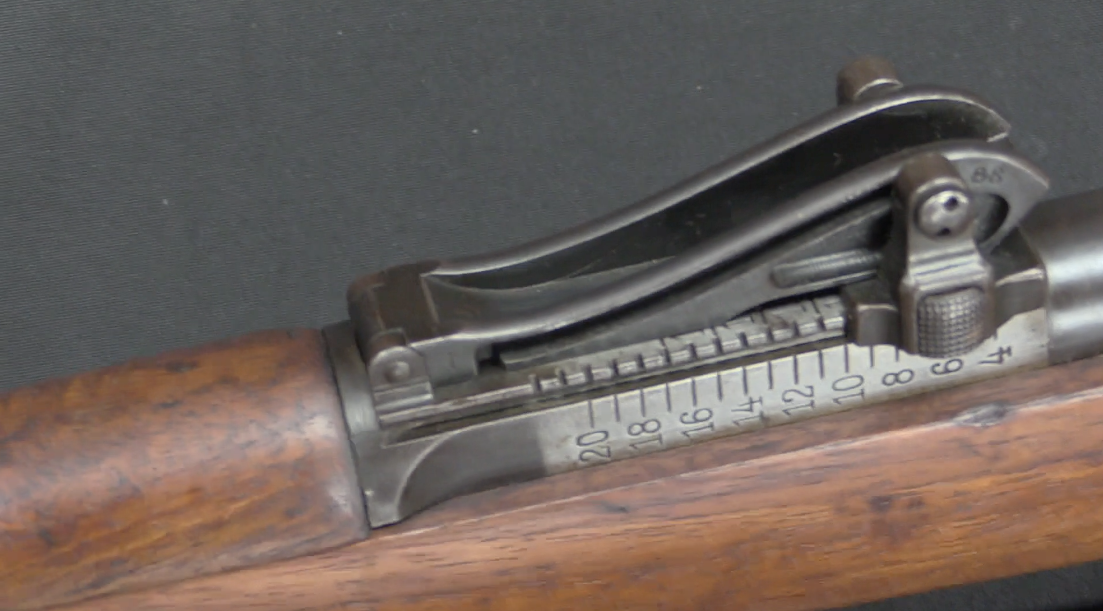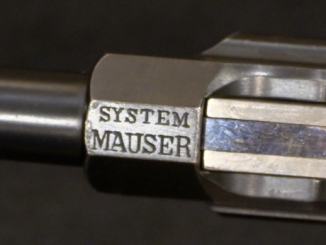While I was visiting the Simpson Ltd shop in Galesburg, I had the pleasure of meeting Nicole Wiley. She is working on organizing a massive reference book on German .22 training rifles (like the Sportmodell and KKW), and was kind enough to give me a tour of Robert Simpson’s collection of these guns. Between his collection (roughly 1200 guns, plus documents and accessories) and several others, all the material is there for a doozy of a book, and Nicole is the one sorting and organizing it all for publication. It’s a huge job, but she has the passion and interest to make it happen, and I’m excited to get a look at the finished product when it’s ready!
If you have questions or are interested in these guns yourself, you can find Nicole and other enthusiasts discussing these rifles over at the .22 trainer and conversion area of www.K98kForum.com.




Well, she’s a character.
Very interesting from a historical as well as a firearms viewpoint. Hats off to her.
Does anyone know if other countries made .22 caliber rifles that replicated their military rifle? I can remember seeing a .22 rifle that duplicated the Enfield in size and weight. I presumed it to be a training rifle, but the action was different.
Almost every country made .22 trainers in the style of their main rifles, but some were closer than others. British trainers were probably the closest to the real rifles, as they were actual Enfield actions rebarreled in .22. The US rifles were only vaguely patterned after Springfields.
US Marines trained with H&R Model 65 .22 rifle which was in terms of dimensions and weight designed to duplicate M1 Garand rifle.
Sure, many nations were manufacturing .22s substitutes of the military rifles. Take Poland for example: first there was a converted (bbl sleeved and firing pin point bent to hit the rim) single shot wz.98 carbines chambered in .22 Short (the .22 LR was mostly used by civilian sportsmen, the Polish military did not switch from .22 Shorts to .22 LR before ww2). These training rifles were designated “karabinek sportowy” (sporting carbine) later also “karabinek sportowy wz.98”. Then in 1931 a new model called ‘karabinek sportowy wz.31’ was designed, simplified and cheaper than converted actual military Mauser, chambered in .22 Short as well and shaped like wz.29 Mauser carbine, down to bayonet lug, tangent sight and doubled sling swivels (one set each of side- and bottom-mounted). The latter was single shot as well, and the design was successful enough to have survived the war. In 1948 it was reinteroduced to the Sovietized army in .22 LR caliber and with sights and stock patterned after Mosin rifle (but no bayonet) as the wz.48 sports carbine. Then, as AK replaced the Mosins, Polish designers created a .22 LR semi-automatic AKM look-alike called the Talk-1. Sadly, it was never series-produced, and then the Communism crumbled and that was that for rifle-shaped training carbines. Only in 2013 the FB Radom has introduced .22LR self-loading Beryl rifles and Mini-Beryl carbines, but the military is not interested, and they would probably end up in civvy street.
Eastern Germany had a trainer version of the AK-47 called the KK-MPi 69 (Kleinkaliber-Maschinenpistole Mod. 69), made in Suhl and issued to the para- (pre-)military GST (Gesellschaft für Sport und Technik).
They’re said to be pretty well made and were select-fire. Around 50.000 were made in total but during reunification most of them disappeared, despite (or due to?) being state property, like many many other things.
A few of them seem to have surfaced in Switzerland. Being select-fire legally excluded them from the German civilian market.
In action:
https://www.youtube.com/watch?v=y_0YzMKiAaY
Wow. Very nice video interview. As my family was much more the Pacific theatre experience ‘back when’, I did not know that Germany had the .22’s in this manner. The history is wonderful, at least as far as something related to Nazi Germany could be. Thanks you both for putting together such a great video/interview. My interest is peaked.
As a 14 and 15 year army cadet in Canada I regularly fired 22 calibre Lee Enfields in the rifle range underneath our high school. I’m not sure if they were conversions or if they were new built as 22s. It was great fun and good practice for us.
One of the big advantages of 22 calibre for training is it was easier to locate the ranges close to where people lived, or even indoors. This was important because people would often be shooting after school or work and in winter you had a limited number of daylight hours. If you restricted shooting to nice days in the summer you severely limited the number of training days in a year. Of course with an indoor range we could shoot even when it was dark outside, but I don’t know if indoor ranges even existed in Germany at the time in question.
For us, we would train in the evenings with the 22 Lee Enfields, but opportunities to fire 7.62mm FN FALs were rarer because we had to travel to “proper” military ranges on a few weekends. Given that, the 22 training rifles made sense from multiple perspectives.
As an aside, the magazines on our Lee Enfields were present, but the follower and spring were removed so the spent cases would fall into the bottom of the magazine where you could dump them out when you were done shooting. It helped keep things neat and tidy. I see on these German training rifles they were designed without even a hole in the receiver for where a magazine would go.
So they were probably the No.8s, which were manufactured as .22 rifles. Most militaries used single-shot trainers, as these were used to attain the basics of marksmanship – and not to pump up the ROF 🙂 Interestingly, Czechoslovak army have chosen air rifles for trainers, and they had the vz.35 training rifle with a hopper for round pellets and a four-stroke cocking handle for cocking the spring loaded piston, which then was released with a trigger and expelled the #10 pellet. The hopper held up to 10 pellets, which could be fired with a reasonable practical rate of fire. The prewar model, vz.35 had a bayonet mount, dispenced with, among the other simplifications, after the war, when it was reintroduced in the army as vz.47 training rifle.
This was quite a while ago, but I seem to recall we had more than one type of .22 Lee Enfield. I believe some were based on the Mk III and some were based on the No. 4.
My local YMCA had .22LRs that approximated Springfields, or Mausers, and I was 11 years old! (1965).
Most of them were Remingtons.
The Cdn .22″ trainers were CNO7 Rifles which were new on new No4 bodies. The No8 was not used in Canada.
That is one knowledgeable lady. I really love the gun culture and the type of people it attracts, especially in relation to the absolutely esoteric things that people latch on to. i didn’t know next to anything about the topic before the video, but now I am more enlightened and there’s clearly a ton to learn.
Thanks for the great video.
Ask her if she wants to be on Inrange TV, she doesn’t have to wear a leather catwoman suit with a Swastika armband to get the viewers in.
Your interview with Nicole Wiley reminds me to a certain extent of past interviews with Teri of NambuWorld.com. Both are very knowledgeable and personable individuals who definitely give the lie to the still-tenacious ( but rapidly-fading ) popular notion that firearms, and their history, are substantially a man’s world. Their shared expertise is always welcome anytime as far as I’m concerned.
Thanks very much for enabling us to expand our horizons via these exceptional women and their vast store of expertise. And, by “exceptional women” I mean exceptional people, regardless of gender, by any standards.
By the way, I must say that Robert Simpson’s armory of German .22-caliber training guns plus support materials and accessories would certainly qualify as a top-notch collection of its kind. Correct me if I am wrong, but it would seem to be one of the most extensive, if not the most extensive, collections of its kind in the world today.
Hi Earl,
It’s certainly an area of interest where neither gender nor gender identity are barriers, or even result in raised eyebrows.
Hi, Keith :
It’s very good to hear from you, and I hope all is well with you and yours! I think your comment certainly holds true in many ways, and should apply in all areas. I was stating my case in the same terms, but I had to also acknowledge the fact that there are are still some areas of the firearms community in which the bias against women — most unfortunately and unjustifiably so — still holds sway , at least to a limited ( but gradually diminishing ) extent. The sooner this gender discrimination dissolves and disappears, the better as far as I am concerned.
An interesting field of study. I think it is a good catch to say that .22 trainers were covert rearmament, rather like the glider sports program.
An excellent and telling point in the historical context — thanks!
France had a long history of cadet rifles starting after the franco prussian war. Yougsters were taught to drill and shoot by the local schoolteachers at the schools.I believed this continued after the first world war to a limited extent as I have .22 flobert copy of the lebel service rifle that is post ww1 perhaps even post ww2
My father was a WW2 vet…I have been a competitive rifle
shooter for 25 years, and this is the rifle that I learned to shoot
as a boy! Gustoff KKW with a German boys name and date
scratched in the floor plate…..Great presentation about the rifle
that I grew up with! Today …..I shoot a Anschutz!
I have recently acquired a Anschutz Germania 22lr training rifle with Nazi proofs
I’m having a hard time finding any information on it
Any help would be appreciated
Nichole, I really enjoyed your You Tube video on the German .22 training rifle. Do you have any for sale? I have one I am looking at and have photos. Would you be able to tell me what a fair price to pay for the rifle? Do you have an e-mail I could send you photos?
Thanks, Jeff